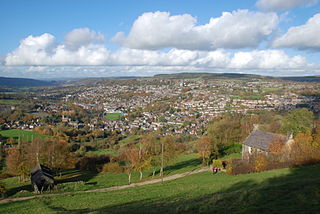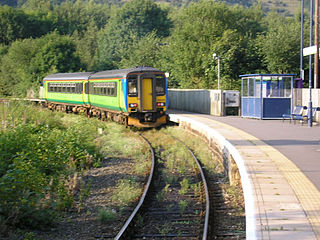County council
Derbyshire
Electoral Divisions from 1 April 1974 (first election 12 April 1973) to 7 May 1981: [1] [2]
- Alfreton No. 1 (1)
- Alfreton No. 2 (1)
- Ashbourne & Hartington (1)
- Bakewell (1)
- Bakewell Rural No. 1 (1)
- Bakewell Rural No. 2 (1)
- Belper No. 1 (1)
- Belper No. 2 (1)
- Belper Rural No. 1 (1)
- Belper Rural No. 2 (1)
- Belper Rural No. 3 (1)
- Blackwell No. 1 (1)
- Blackwell No. 2 (1)
- Blackwell No. 3 (1)
- Blackwell No. 4 (1)
- Bolsover (1)
- Buxton North (1)
- Buxton South (1)
- Chapel-en-le-Frith No. 1 (1)
- Chapel-en-le-Frith No. 2 (1)
- Chesterfield No. 1 (1)
- Chesterfield No. 2 (2)
- Chesterfield No. 3 (1)
- Chesterfield No. 4 (2)
- Chesterfield No. 5 (1)
- Chesterfield No. 6 (1)
- Chesterfield Rural No. 1 (1)
- Chesterfield Rural No. 2 (1)
- Chesterfield Rural No. 3 (1)
- Chesterfield Rural No. 4 (1)
- Chesterfield Rural No. 5 (1)
- Chesterfield Rural No. 6 (1)
- Chesterfield Rural No. 7 (1)
- Clay Cross (1)
- Clowne (1)
- Derby Abbey (2)
- Derby Allestree (2)
- Derby Alvaston (1)
- Derby Arboretum (1)
- Derby Babington (2)
- Derby Breadsall (1)
- Derby Chaddesden (1)
- Derby Chellaston (2)
- Derby Darley (1)
- Derby Derwent (1)
- Derby Friar Gate (2)
- Derby Litchurch (1)
- Derby Littleover (1)
- Derby Mickleover (2)
- Derby Normanton (1)
- Derby Osmaston (1)
- Derby Pear Tree (1)
- Derby Spondon (1)
- Dronfield (2)
- Elmton & Whitwell (1)
- Glossop No. 1 (1)
- Glossop No. 2 (1)
- Heanor No. 1 (1)
- Heanor No. 2 (1)
- Heanor No. 3 (1)
- Ilkeston No. 1 (1)
- Ilkeston No. 2 (1)
- Ilkeston No. 3 (1)
- Ilkeston No. 4 (1)
- Long Eaton No. 1 (2)
- Long Eaton No. 2 (1)
- Long Eaton No. 3 (1)
- Matlock No. 1 (1)
- Matlock No. 2 (1)
- New Mills No. 1 (1)
- New Mills No. 2 (1)
- Repton No. 1 (1)
- Repton No. 2 (1)
- Repton No. 3 (1)
- Ripley No. 1 (1)
- Ripley No. 2 (1)
- South East Derbyshire No. 1 (1)
- South East Derbyshire No. 2 (1)
- South East Derbyshire No. 3 (1)
- South East Derbyshire No. 4 (1)
- Staveley East (1)
- Staveley West (1)
- Sudbury (1)
- Swadlincote No. 1 (1)
- Swadlincote No. 2 (1)
- Swadlincote No. 3 (1)
- Whaley Bridge (1)
- Wirksworth (1)
Electoral Divisions from 7 May 1981 to 5 May 2005: [2] [3]
- Abbey (1); electoral division abolished in 1997 [4]
- Alfreton (1)
- Allestree (1); electoral division abolished in 1997 [4]
- Alport (1)
- Alvaston (1); electoral division abolished in 1997 [4]
- Ashbourne (1)
- Babington (1); electoral division abolished in 1997 [4]
- Bakewell (1)
- Barlborough & Clowne (1)
- Belper (1)
- Blagreaves (1); electoral division abolished in 1997 [4]
- Bolsover (1)
- Boulton (1); electoral division abolished in 1997 [4]
- Brackenfield (1)
- Breadsall (1); electoral division abolished in 1997 [4]
- Brimington (1)
- Buxton North (1)
- Buxton South (1)
- Chaddesden (1); electoral division abolished in 1997 [4]
- Chapel (1)
- Chellaston (1); electoral division abolished in 1997 [4]
- Chesterfield North (1)
- Clay Cross (1)
- Cotmanhay (1)
- Darley (1); electoral division abolished in 1997 [4]
- Darley Dale (1)
- Derwent (1); electoral division abolished in 1997 [4]
- Draycott (1)
- Dronfield North (1)
- Dronfield South (1)
- Duffield (1)
- Eckington (1)
- Elmton (1)
- Etwall (1)
- Glossop East (1)
- Glossop South (1)
- Glossop West (1)
- Hasland & St Leonards (1)
- Heage (1)
- Heanor (1)
- Holmebrook & Rother (1)
- Holymoor & Wingerworth (1)
- Horsley (1)
- Ilkeston (1)
- Killamarsh (1)
- Kingsway (1); electoral division abolished in 1997 [4]
- Kirk Hallam (1)
- Linton (1)
- Litchurch (1); electoral division abolished in 1997 [4]
- Littleover (1); electoral division abolished in 1997 [4]
- Long Eaton (1)
- Loscoe (1)
- Mackworth (1); electoral division abolished in 1997 [4]
- Matlock (1)
- Melbourne (1)
- Mickleover (1); electoral division abolished in 1997 [4]
- Moor & St Helens (1)
- New Mills (1)
- Newbold & Brockwell (1)
- Newhall (1)
- Normanton (1); electoral division abolished in 1997 [4]
- North Wingfield (1)
- Osmaston (1); electoral division abolished in 1997 [4]
- Petersham (1)
- Repton (1)
- Ripley (1)
- Sandiacre (1)
- Sawley (1)
- Scarcliffe (1)
- Sheepbridge (1)
- Shirebrook (1)
- Sinfin (1); electoral division abolished in 1997 [4]
- Somercotes (1)
- South Normanton (1)
- Spondon (1); electoral division abolished in 1997 [4]
- Staveley (1)
- Sutton (1)
- Swadlincote (1)
- Tibshelf (1)
- Tideswell (1)
- Walton & West (1)
- West Hallam (1)
- Whaley Bridge (1)
- Wirksworth (1)
Electoral Divisions from 5 May 2005 to 2 May 2013: [5]

- Alfreton (1)
- Alport & Derwent (1)
- Ashbourne (1)
- Ashgate (1)
- Aston & Melbourne (1)
- Bakewell (1)
- Barlborough & Clowne (1)
- Belper (1)
- Birdholme (1)
- Bolsover North West, Elmton & Whitwell (1)
- Bolsover South West & Scarcliffe (1)
- Breadsall & West Hallam (1)
- Breaston (1)
- Brimington (1)
- Buxton North & East (1)
- Buxton West (1)
- Chapel & Hope Valley (1)
- Clay Cross (1)
- Cotmanhay (1)
- Derwent Valley (1)
- Dovedale (1)
- Dronfield North (1)
- Dronfield South (1)
- Duffield & Belper South (1)
- Eckington (1)
- Etherow (1)
- Glossop North & Rural (1)
- Glossop South (1)
- Greater Heanor (1)
- Hatton & Hilton (1)
- Heage (1)
- Heanor Central (1)
- Hipper (1)
- Holymoorside & Wingerworth (1)
- Horsley (1)
- Ilkeston (1)
- Killamarsh (1)
- Kirk Hallam (1)
- Linton & Church Gresley (1)
- Long Eaton (1)
- Matlock (1)
- Midway & Hartshorne (1)
- New Mills (1)
- Newbold (1)
- Newhall & Seales (1)
- North Wingfield & Tupton (1)
- Petersham (1)
- Pinxton & South Normanton West (1)
- Repton & Willington (1)
- Ripley (1)
- Sandiacre (1)
- Sawley (1)
- Shirebrook & Pleasley (1)
- Somercotes (1)
- South Normanton East & Tibshelf (1)
- Spire (1)
- St Mary's (1)
- Staveley North & Whittington (1)
- Staveley South (1)
- Stonebroom & Pilsley (1)
- Sutton (1)
- Swadlincote Central & Woodville (1)
- Whaley Bridge & Blackbrook (1)
- Wirksworth (1)
Electoral Divisions from 2 May 2013 to present: [6]

- Alfreton & Somercotes (2)
- Alport & Derwent (1)
- Ashbourne (1)
- Aston (1)
- Bakewell (1)
- Barlborough & Clowne (1)
- Belper (1)
- Birdholme (1)
- Bolsover North (1)
- Bolsover South (1)
- Boythorpe & Brampton South (1)
- Breadsall & West Hallam (1)
- Breaston (1)
- Brimington (1)
- Buxton North & East (1)
- Buxton West (1)
- Chapel & Hope Valley (1)
- Clay Cross North (1)
- Clay Cross South (1)
- Derwent Valley (1)
- Dovedale (1)
- Dronfield East (1)
- Dronfield West & Walton (1)
- Duffield & Belper South (1)
- Eckington & Killamarsh (2)
- Etherow (1)
- Etwall & Repton (1)
- Glossop & Charlesworth (2)
- Greater Heanor (1)
- Heanor Central (1)
- Hilton (1)
- Horsley (1)
- Ilkeston East (1)
- Ilkeston South (1)
- Ilkeston West (1)
- Linton (1)
- Long Eaton (1)
- Loundsley Green & Newbold (1)
- Matlock (1)
- Melbourne (1)
- New Mills (1)
- Petersham (1)
- Ripley East & Codnor (1)
- Ripley West & Heage (1)
- Sandiacre (1)
- Sawley (1)
- Shirebrook & Pleasley (1)
- South Normanton & Pinxton (1)
- Spire (1)
- St Mary’s (1)
- Staveley (1)
- Staveley North & Whittington (1)
- Sutton (1)
- Swadlincote Central (1)
- Swadlincote North (1)
- Swadlincote South (1)
- Tibshelf (1)
- Walton & West (1)
- Whaley Bridge (1)
- Wingerworth & Shirland (1)
- Wirksworth (1)




















